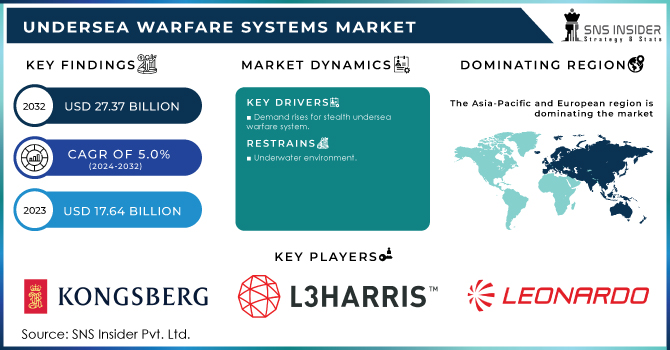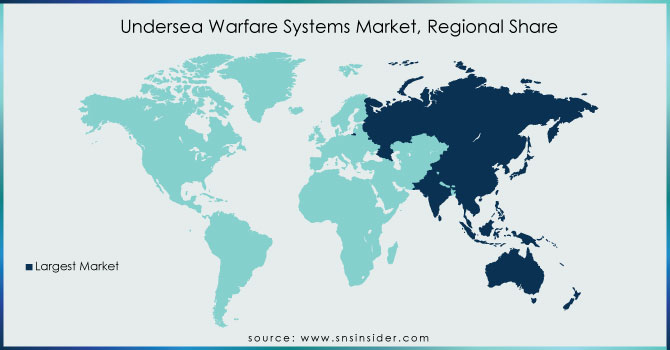Undersea Warfare Systems Market Report Scope & Overview:

To get more information on Undersea Warfare Systems Market - Request Free Sample Report
The Undersea Warfare Systems Market Size was valued at USD 17.64 billion in 2023 and is expected to reach USD 27.37 billion by 2032 with a growing CAGR of 5.0% over the forecast period 2024-2032.
Underwater tactics are means of attacking and defeating an enemy ship or fleet at sea during a conflict. The battlespace is the core idea of underwater warfare. It is a zone around a naval force in which a commander is sure of discovering, monitoring, engaging, and destroying enemies before they pose any harm to the relevant country. Surveillance (patrolling of littoral waters bounded by hostile coasts and harbors), reconnaissance which means gathering information from acoustic, electromagnetic, and optronic sensors without being detected, engagement means deploying missiles and torpedoes unanticipated by the enemy, and self-protection are all key functions of underwater warfare systems (utilizing forward-looking active sonar integrated torpedo counter systems). Underwater warfare systems must be adaptable enough to operate in complex naval battles.
Unmanned vehicles and maritime robots, stealth submarines, improved sonar detection ranges, undersea communications, and network-centric warfare, among other improvements in maritime technology, are expected to increase investment in R&D initiatives.
MARKET DYNAMICS
KEY DRIVERS
-
Demand rises for stealth undersea warfare system
RESTRAINTS
-
Underwater environment
-
Underwater threat protection
OPPORTUNITIES
-
Destroy enemy before it’s attacking
-
Enhance surveillance
-
Lightweight torpedoes
CHALLENGES
-
High operational cost
-
Endurance of submarine
IMPACT OF COVID-19
The COVID-19 crisis has created uncertainty in the submarine military industry, a sharp decline in supply chain, a decline in business confidence, and an increase in panic among customer segments. The governments of various regions have announced the complete closure and temporary closure of factories, thus having a negative impact on total production and sales. The impact of the COVID-19 epidemic has led to delays in the development of submarine warfare systems and declining tests and demonstrations and limitations on key player performance. Governments around the world have prioritized the healthcare industry to combat the COVID-19 virus, which has adversely affected the functioning of the defense industry. Epidemic closures were removed and re-introduced to curb the spread of COVID-19 infections as public services were gradually opened up in major countries such as the UK, India and Italy. Lack of components, sub-systems, and electronic systems, due to regulations related to the import and export of goods has caused production delays. The development of submarine military systems has also had an impact due to material shortages, due to production closures in China, South Korea and Taiwan. However, in the aftermath of the epidemic, improvements in the submarine systems have been observed. With the relaxation of door-closure measures, vaccination measures, and the opening of global markets, the demand for submarine military systems is expected to grow significantly in the near future.
It analyzed the submerged fighting business sector in light of frameworks, sensor frameworks, electronic help measures, and combat hardware. Sensor frameworks incorporate different sub-frameworks like sonar, radar, and optronics. Electronic help estimates comprise of three significant classes imaging frameworks, correspondence frameworks, and electronic fighting frameworks. Weapons incorporate torpedoes, land-assault voyage rockets, long range rockets, and mines. Alongside it, the report gives an in-nitty gritty market size examination of the submerged fighting business sector in light of stages like submarines, surface boats, helicopters, oceanic watch airplane, and automated frameworks. The report additionally gives an in-definite market size examination of the submerged fighting business sector in view of end-utilize, for example, maritime, airborne, and land-based. The ascent sought after for secrecy undersea fighting frameworks, the presentation of submerged drones for undersea fighting, and government backing for further developing undersea fighting abilities are the essential driving drivers in the overall undersea fighting frameworks market. Nonetheless, the functional intricacy of undersea automated frameworks, as well as the high forthright and functional costs of assault submarines, are obstructing market development. Running against the norm, the improvement of lightweight torpedoes and an expansion in the protection spending plan are probably going to produce beneficial market possibilities for overall market progression over the projection period. Different nations all over the planet are tracking down ways of acquiring conspicuousness in maritime tasks to further develop their protection abilities. As water covers more than 3/fourth of the outer layer of the earth, fortifying the naval force is fundamental to effectively safeguard land borders. U.S. authorities Maritime Undersea Fighting Place Division has granted agreements worth $ 49 million to 13 Sensors project organizations and the Sonar C15 Fast Prototyping Advancement. The 13 organizations will foster exploration techniques to apply to above warships, submarines, reconnaissance, confidential vehicles, submarines, appropriated networks, interesting fights, and airplane. Likewise, Australian Protection Priest Peter Dutton has reported a $ 1.44 billion interest in the improvement of automated submarine innovation to fortify Australia's tactical capacities in the midst of local struggles. Such advancements are supposed to animate the development of the submarine military market.
KEY MARKET SEGMENTATION
By Systems
-
Sensors
-
Electronic support measures
-
Armaments
By End-Use
-
Naval
-
Airborne
-
Land-based
By Application
-
Combat
-
C4ISR
-
Others
By Platforms
-
Submarines
-
Surface Ships
-
Maritime Patrol Aircrafts
-
Unmanned Systems
By Type
-
Weapon Systems
-
Communication and Surveillance Systems
-
Sensors and Computation Systems
-
Countermeasure Systems and Payload
-
Unmanned Underwater Vehicles
By Mode of Operation
-
Manned Operations
-
Autonomous Operations
-
Remotely Operations
REGIONAL ANALYSIS
The Asia-Pacific and European areas are likely to experience considerable growth during the forecast period, owing to the increasing acquisition of new submarines by naval forces as well as enhanced upgradation projects for existing submarines carried out in these regions. The increase can also be ascribed to a considerable increase in spending on improving maritime security.

Need any customization research on Undersea Warfare Systems Market - Enquiry Now
REGIONAL COVEREGE:
-
North America
-
USA
-
Canada
-
Mexico
-
-
Europe
-
Germany
-
UK
-
France
-
Italy
-
Spain
-
The Netherlands
-
Rest of Europe
-
-
Asia-Pacific
-
Japan
-
south Korea
-
China
-
India
-
Australia
-
Rest of Asia-Pacific
-
-
The Middle East & Africa
-
Israel
-
UAE
-
South Africa
-
Rest of Middle East & Africa
-
-
Latin America
-
Brazil
-
Argentina
-
Rest of Latin America
-
KEY PLAYERS
The Major Players are Kongsberg Gruppen, L3Harris Technologies Inc., General Dynamic Corporation, Leonardo S.p.A., Northrop Grumman Corporation, Lockheed Martin Corporation, Raytheon Technologies Corporation, SAAB AB, BAE Systems Plc., Thales Group and Other Players
| Report Attributes | Details |
|---|---|
| Market Size in 2023 | US$ 17.64 Billion |
| Market Size by 2032 | US$ 27.37 Billion |
| CAGR | CAGR of 5.0% From 2024 to 2032 |
| Base Year | 2023 |
| Forecast Period | 2024-2032 |
| Historical Data | 2020-2022 |
| Report Scope & Coverage | Market Size, Segments Analysis, Competitive Landscape, Regional Analysis, DROC & SWOT Analysis, Forecast Outlook |
| Key Segments | • By Systems (Sensors, Electronic support measures, Armaments) • By End-Use (Naval, Airborne, Land-based) • By Application (Combat, C4ISR, Others) • By Platforms (Submarines, Surface Ships, Helicopters, Maritime Patrol Aircrafts and Unmanned Systems) • By Type (Weapon Systems, Communication and Surveillance Systems, Sensors and Computation Systems, Countermeasure Systems and Payload, Unmanned Underwater Vehicles) • By Mode of Operation (Manned Operations, Autonomous Operations, Remotely Operations) |
| Regional Analysis/Coverage | North America (USA, Canada, Mexico), Europe (Germany, UK, France, Italy, Spain, Netherlands, Rest of Europe), Asia-Pacific (Japan, South Korea, China, India, Australia, Rest of Asia-Pacific), The Middle East & Africa (Israel, UAE, South Africa, Rest of Middle East & Africa), Latin America (Brazil, Argentina, Rest of Latin America) |
| Company Profiles | Kongsberg Gruppen, L3Harris Technologies Inc., General Dynamic Corporation, Leonardo S.p.A., Northrop Grumman Corporation, Lockheed Martin Corporation, Raytheon Technologies Corporation, SAAB AB, BAE Systems Plc., and Thales Group. |
| DRIVERS | • Demand rises for stealth undersea warfare system |
| RESTRAINTS | • Underwater environment • Underwater threat protection |

